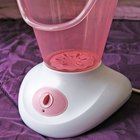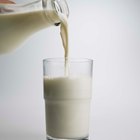
Professional baristas learn to steam and froth milk so they can create perfect cappuccinos and lattes time after time. Espresso machines designed for home use rarely have the same oomph as commercial models, but you can tap into some of those tricks to produce a pleasing cup at home. To steam milk, you heat it rapidly using high-pressured steam. When you introduce air into the milk, you add volume and create froth. For richness and texture but less froth, use high-fat milk. For fewer calories and more froth, choose low-fat milk.
Tools of the Trade
Tools required for steaming and frothing milk include an espresso machine with a steam wand, a steaming pitcher, a thermometer and a damp cloth. A stainless steel milk pitcher conducts heat better than a plastic pitcher. Use a thermometer to check the temperature as you steam the milk, unless you can accurately gauge the temperature with your hand on the pitcher. Keep a damp cloth on hand to clean the steam arm and prevent moisture from watering down the milk.
Frothed Milk
Frothed milk, the smooth, nearly imperceptible foam that sits on top of cappuccinos, lattes and mochas, results from air being introduced into the milk when you steam it. Although steaming and frothing take place simultaneously in the same pitcher, the placement of the steam arm determines the amount and quality of foam you produce. The steam arm should be fully submerged in the milk, but not to the bottom of the pitcher or touching the side, before you turn it on to prevent large bubbles from forming. Turn the steam to full power immediately, then pull the wand tip almost out of the milk to start coaxing the froth from the milk. Listen for a distinctive “tsss” sound that lets you know you're in the right place.
Steamed Milk
Once you achieve the desired froth, dip the steam arm back into the center region in the pitcher to heat the rest of the milk. Steamed milk takes from 10 to 60 seconds, depending on your machine. Little or no sound indicates correct placement of the steam arm, which you want to hold in place until the milk reaches 150 to 155 degrees Fahrenheit. Higher temperatures can result in scalded milk that taints the coffee with a burnt flavor.
Helpful Tips
Frothed milk expands more than steamed milk, so don’t fill the milk pitcher past half full. Before you start and again when you're done, expel excess steam from the nozzle by turning the wand on for a quick blast into your damp cloth to prevent fluid build-up in the tip, which can water-down the steamed milk. When frothing milk, stretch the froth no more than 50 percent in volume to create a pattern or design on your latte surface. Froth slightly longer for a classic cappuccino.
Related Articles

How to Froth Milk With the Magic Bullet
How to Scald Milk for Cooking

How to Froth Milk With Hand Blenders

Krups 880 Instructions

How to Make Mocha With an Espresso ...

How to Separate Curds From Whey

Estro Vapore Espresso Machine Specs

Steaming a Chiffon Wedding Dress

How to Remove Wrinkles From Polyester ...

How to Make Frothy Steamed Milk

Homemade Oatmeal Facial Cleansers

How to Separate Fat Without a Fat ...

How to Decrease the Padding in a Bra

How to Use the Steam Buddy

How to Unwrinkle Sweaters

How to Use the Facial Sauna

Why Does Milk Freeze in the ...

How to Remove Creases From Sweaters

How Long Are Tamales Supposed to Cook?

What Happens if You Whip Condensed Milk?
References
Writer Bio
Katherine Marko has been a professional writer for more than five years. She has attended the University of Toronto for English. Her work has appeared in several online publications. Marko is also a licensed aesthetician with expertise in nutrition and beauty.
Photo Credits
Jupiterimages/Comstock/Getty Images